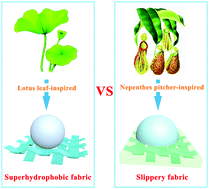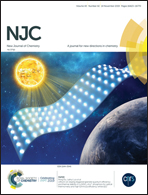Superhydrophobic and slippery cotton fabrics with robust nanolayers for stable wettability, anti-fouling and anti-icing properties†
Abstract
Inspired by natural surface such as lotus leaves and pitcher plants, superhydrophobic and slippery lubricant-infused surfaces have received widespread attention in the field of material surface engineering owing to their universal functionalization. However, the environmental durability of both types of surfaces is still a challenging issue, especially under harsh or extreme conditions, such as strong acid or alkaline conditions and high humidity. The performances of superhydrophobic (SHB) and slippery liquid-infused (SLI) fabric substrates (soft substrates) have not been compared yet. In this study, a simple hydrothermal method to prepare ZnO nanostructures on fabric surfaces has been conducted, and followed by fluorination. A thin lubricant film could be firmly retained by the as-prepared rough topography and the fluorinate-rich surface, forming a slippery surface with excellent liquid repellence properties. Compared with the superhydrophobic fabric, the slippery lubricant-infused fabric exhibited anti-acid, anti-alkaline, salt tolerance, oil repellence and high-humidity repellence properties. However, the superhydrophobic fabric could not maintain its superhydrophobic properties under the same conditions owing to the vulnerable air film among the nanostructures. At the same time, the slippery fabric demonstrated self-cleaning and anti-fouling properties for more types of pollution than the superhydrophobic fabric, especially for low surface energy liquids. More importantly, the fluorinated hierarchically nano/micro-structure of the slippery fabric will enable the lubricant to completely cover the surface, which reduces the nucleation and frost propagation velocity, and thus contributes to a delay in the icing time. This study will expand the potential applications of functional fabrics, and the results indicate that the slippery fabric may have wide scale practical applications through utilization of its superior and stable wettability under harsh conditions.



 Please wait while we load your content...
Please wait while we load your content...